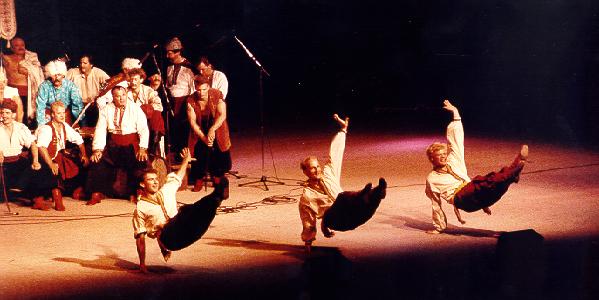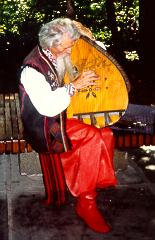Keivan Rus declined under the constant attacks by the Tatars on the east and the gradual encroachment of Poland and Lithuania on the west. During the late 1400s, the raiding Tatars so devastated the lands of southern Rus that for several decades the area was almost abandoned. Those devastated lands became known as the Ukraine, meaning borderland, because they were at the edge of the civilized Christian world.
The lands were extremely fertile and the wildlife very bountiful so in spite of the Tatar threat, the more hearty souls slowly began to move back into the territory and took up hunting, fishing and bee-keeping. These people came to be known as the Cossacks. On the wild steppe, they were free from the government and gentry. On their return to their homes in the winter, however, they were again under the thumbs of the Polish government officials and the landlords. As a result, some of the Cossacks remained on the steppe permanently. But for the most part being a Cossack was a popular part-time pursuit, with people from all levels and occupations of Ukrainian society joining.
Over time, the Cossacks gradually banded together for mutual protection and soon the bold upstarts were avenging themselves on the hated Turk and Tatar heathens. As the Cossacks became more involved in warfare, they became more organized. They elected a Hetman as their leader and built little fortified military camps known as siches for protection. Their headquarters, naturally well-protected from attack, was the legendary Zaporogian Sich on the Dnieper River. War munitions were kept there and military training undertaken. As the exploits of the Cossacks became more well-known, these fearless warriors, who dared take on the dreaded Tatars and sail the Black Sea plundering the mighty Turkish empire which had arisen to the south, became popular folkheros of the Ukrainian people. Their exploits gave birth to many of the folk tales, songs and dances that are a popular part of the Ukrainian culture today.
 (The dancers shown in the photograph above are members of a cossack dance group from Winnipeg appearing at the Ukrainian Canadian National Festival in Dauphin, Manitoba. Their dances reflect the hard life of the Cossacks. No women were allowed in the Sich but after battle the liquor flowed freely and the men would try to upstage each other by showing off their agility and athletic prowess in their dances.)
(The dancers shown in the photograph above are members of a cossack dance group from Winnipeg appearing at the Ukrainian Canadian National Festival in Dauphin, Manitoba. Their dances reflect the hard life of the Cossacks. No women were allowed in the Sich but after battle the liquor flowed freely and the men would try to upstage each other by showing off their agility and athletic prowess in their dances.)
During the Cossack era, practically all of the ethnic Ukrainian lands came under Polish rule. Under the Poles, the Polish aristocracy gradually took possession of the southern Ukrainian lands which had been devastated by the Tatars and later repopulated under the protection of the Cossacks. Polish laws were introduced which gradually restricted the freedom of the Ukrainian peasants until they were reduced to the status of serfs. The Poles also began to push Catholicism on the Orthodox Ukrainians. As outright conversion failed, the Poles attempted to gradually win the Ukrainians over to Catholicism by first introducing a compromise religion known as Uniate, or Greek Catholic, then full Catholicism. The Poles were most successful with the Ukrainian gentry because those members of the Ukrainian gentry who refused to learn Polish and accept Catholicism were squeezed out. This seriously harmed the Ukrainian national cause because it resulted in a loss of the Ukrainian gentry, the class which would normally have provided leadership to the nation. However, pushing Catholicism on the Ukrainians only added to the social unrest because the Ukrainian peasants clung to their Othodox religion tenaciously.
Meanwhile, the exploits of the independent-minded Cossacks embarrassed and caused problems for the Polish king who was fearful of Turk and Tatar reprisals but in spite of his attempts, he could not control the unruly but powerful Cossacks. Over time, the Cossack leaders came to consider the Cossack Host answerable only to the king but the Cossacks as a whole saw themselves as free men subject only to their own elected officials with no responsibility other than to fight frontier enemies. As word of the Cossacks' freedom spread, their numbers swelled with those who desired to escape the oppression of their Polish landlords. And as the Cossack host grew, the territory over which they had influence spread from the frontier to the other more settled parts of the Ukraine and a Cossack aristocracy grew up. However, although the Poles were happy to have the Cossacks fight for them in times of danger, during times of peace the Polish gentry whose serfs had gone over to the Cossacks attempted to have the Cossack Host brought under control. But their efforts were in vain. Their attempts led to increasing conflict between the Poles and the Cossacks though.
In 1648, a general revolt swept the Ukraine. The Cossacks under Bohdan Khmelnytsky, one of the most famous Cossack Hetman, rose up against the Poles, the Orthodox believers attacked the Catholics, and the peasants revolted against the gentry. Khmelnytsky defeated the Polish army in battle after battle and in the end, although the Ukraine was nominally still under Poland, it was practically speaking an automomous state. A Hetman administration was instituted, the peasants were freed from serfdom, and Ukraine finally achieved some degree of freedom.
After the war, Khmelnytsky looked for an ally to strengthen his position and chose Muscovy which had arisen from the principalities in the north of ancient Rus. Muscovy eventually grew into modern day Russia. In 1654, Khmelnytsky signed a treaty with the Tsar of Muscovy but the Tsar merely treated that as an invitation to move his troops into the Ukraine. Futhermore, in 1667, behind the Ukrainians' backs, Moscow made an agreement with Poland whereby Poland got the Ukraine west of the Dnieper River while Moscow got that to the east. During the following years, the strife and devastation from the Polish, Muscovite, Tatar, Turkish and competing Cossack forces was so great that many of the inhabitants emigrated from the west Ukraine and it entered a period known as 'The Ruin'.
 (The gentleman shown in the photograph to the left is a Kobzar, or wandering minstral. When the Cossacks became too old to fight, they would often wander the land with their bandura singing and telling tales of the mighty Cossacks and their exploits. This Kobzar is at the grave site of Taras Shevchenko, the great Ukrainian poet and artist, in Ukraine.)
(The gentleman shown in the photograph to the left is a Kobzar, or wandering minstral. When the Cossacks became too old to fight, they would often wander the land with their bandura singing and telling tales of the mighty Cossacks and their exploits. This Kobzar is at the grave site of Taras Shevchenko, the great Ukrainian poet and artist, in Ukraine.)
The heavy hand of the Russians was felt by the populace in eastern Ukraine and in 1709, another famous Hetman, Ivan Mazepa, attempted to gain the independence of the Ukraine. He made an alliance with the Swedish king and they engaged the Russians at the battle of Poltava. The battle was lost, however, and the Tsar used it as an excuse to tighten his grasp on the Ukraine. Over the following years, the autonomy of the Ukraine was removed. The peasants again fell into serfdom, the Zaporogian Sich was destroyed and the old Hetmanic system of the Cossacks was abolished. For the second time in its history, foreign interference stripped the Ukraine of its educated upper class and the struggle to keep the national culture and language fell to the peasants. The value of the Cossack period cannot be underestimated though, for it brought about a national revival and prevented the assimilation of the Ukrainians.

 (The gentleman shown in the photograph to the left is a Kobzar, or wandering minstral. When the Cossacks became too old to fight, they would often wander the land with their bandura singing and telling tales of the mighty Cossacks and their exploits. This Kobzar is at the grave site of Taras Shevchenko, the great Ukrainian poet and artist, in Ukraine.)
(The gentleman shown in the photograph to the left is a Kobzar, or wandering minstral. When the Cossacks became too old to fight, they would often wander the land with their bandura singing and telling tales of the mighty Cossacks and their exploits. This Kobzar is at the grave site of Taras Shevchenko, the great Ukrainian poet and artist, in Ukraine.)

